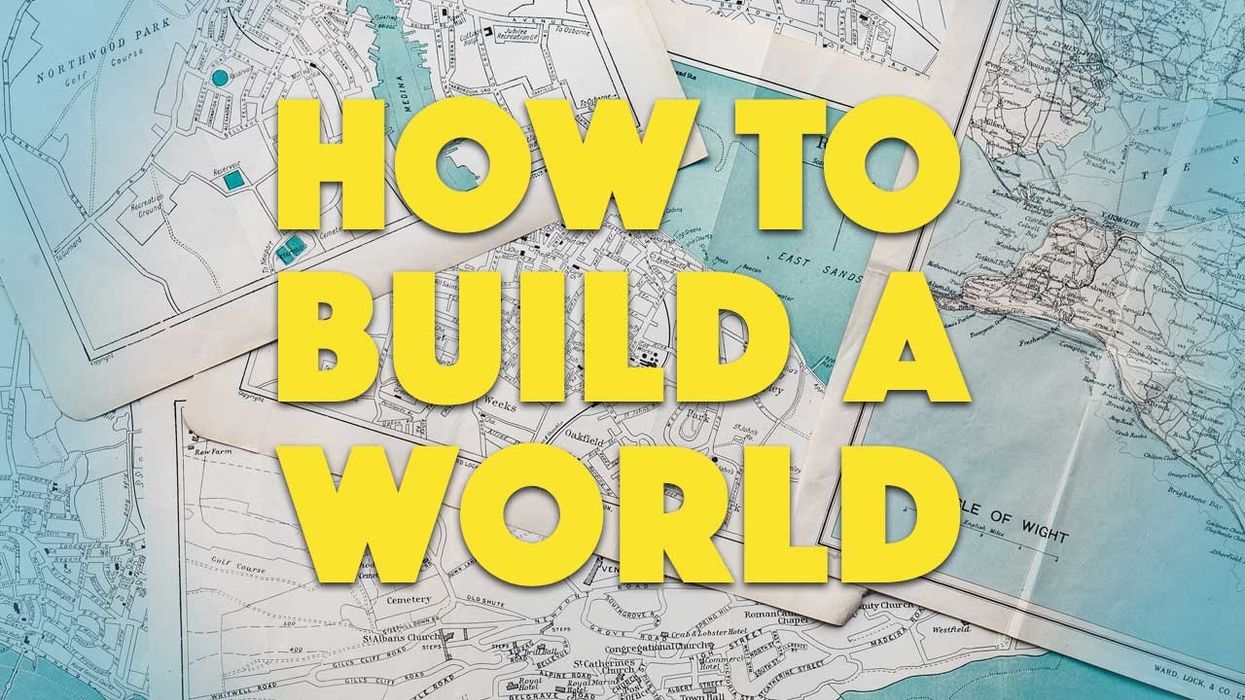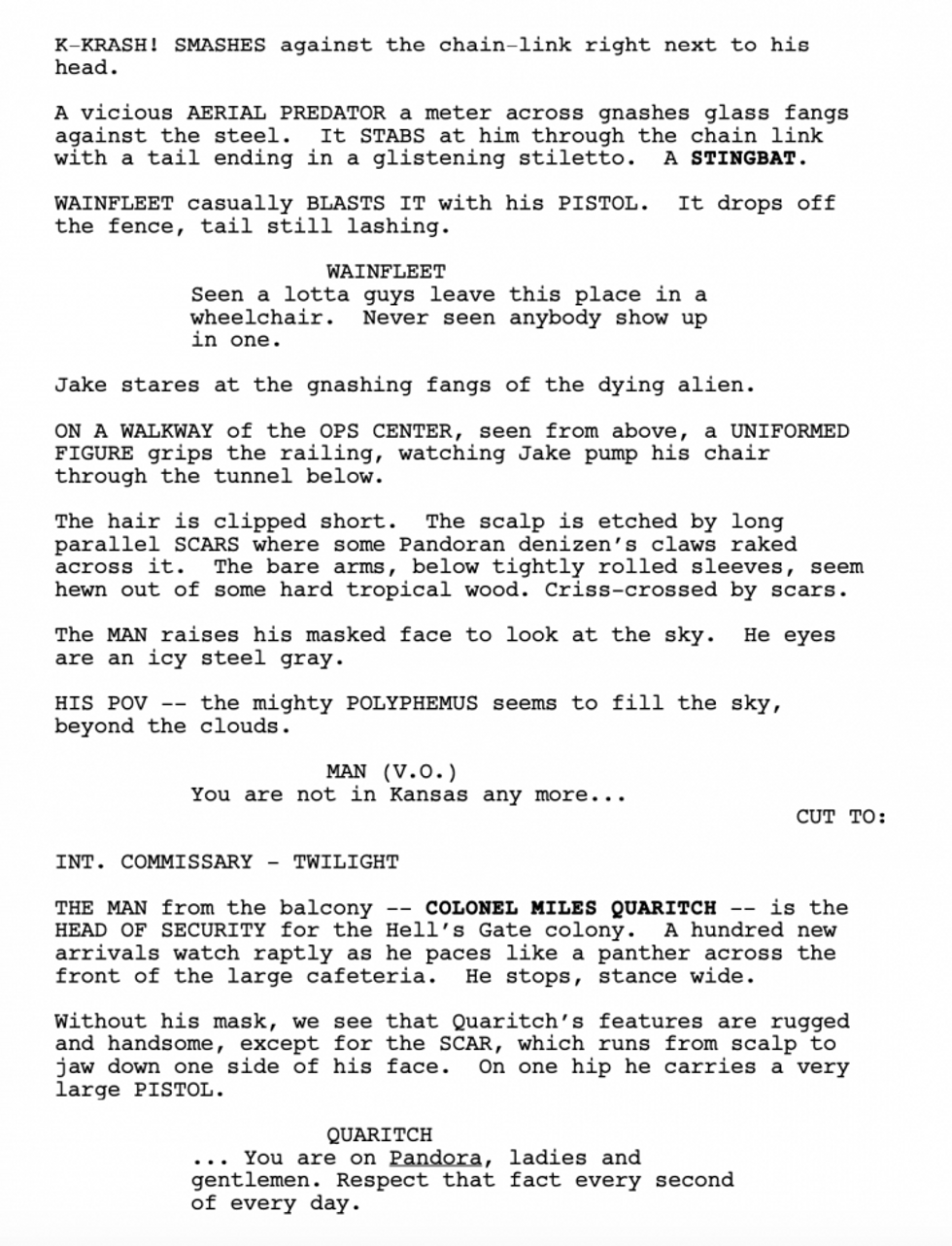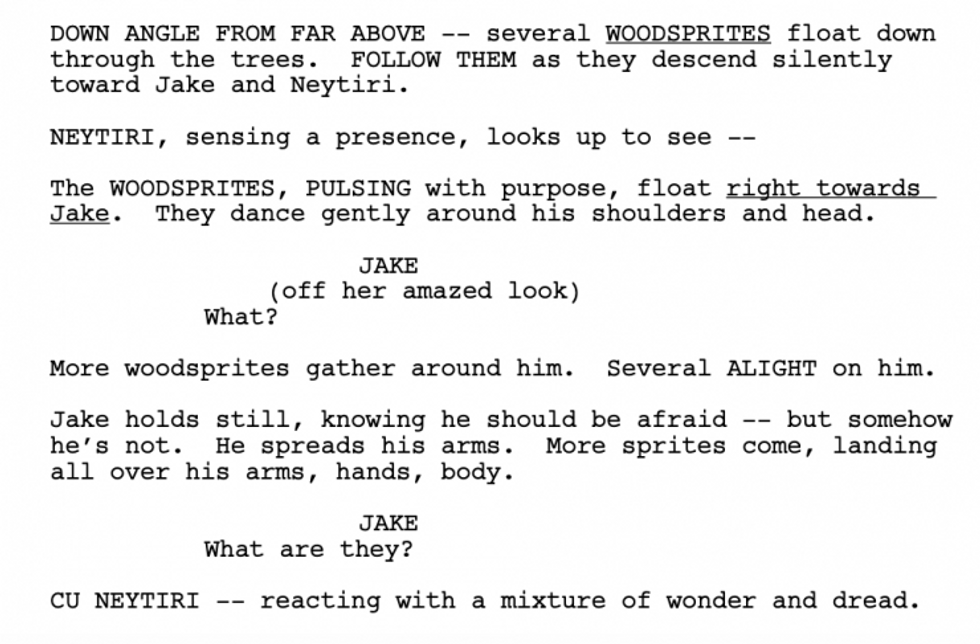A Worldbuilding Template for Filmmakers
How can you world-build within your screenplay without feeling expository or over the top?

A Worldbuilding Guide for Filmmakers
The best screenplays in the world completely absorb you into the story.
You get so deep into what's happening on the page (or on the screen) that you forget that there was a person or group of people working in a room to make that story special. To create evocative reactions to your work, you need to be an expert at worldbuilding.
Today, I want to look at why worldbuilding is a screenwriter's most powerful tool and why you should try our template.
We've also created a free template you can use to enhance your skills in this area.
Let's dive in.
Table of Contents:
- Worldbuilding Definition
- Why is Worldbuilding Important?
- How to Worldbuild Across Genres
- What about when we have to build a whole new world?
- Worldbuilding Templates (and other tips and tools)
- 1. Build a Map
- 2. Rewrite the Physical Laws
- 3. Build a timeline
- 4. Think About The Sociology
- Our Free Worldbuilding Template
- 20 Common Mistakes Within Worldbuilding
- Breaking Down Our Worldbuilding Tool
Worldbuilding definition
Worldbuilding is the multi-layered process of using your imagination to create a world or entire universe. In fiction, cinema, and television, this process helps the audience get lost within the story and focus only on the narrative at hand.
Why is Worldbuilding Important?

Hunger Games (top) Blade Runner 2049 (bottom)
Lionsgate and Fox
You're going to be worldbuilding every time you write. If you're making up a story, you're also defining the world. That means it's crucial that you think about the world as much as you think about the characters within it.
So what kind of world will your characters live in?
There's a good chance you have not thought about this when writing, and that could be the main thing holding you back. The world informs the characters, story, tone, and genre.
And it does not matter what you're writing.
You're always worldbuilding.
How to Worldbuild Across Genres
 'Breaking Bad'
'Breaking Bad'AMC
When you think about worldbuilding, you probably think about genres like science fiction or fantasy. But the truth is, every screenplay you write needs to establish the world.
Lots of times, the world we're writing reflects our own. But what sets genres and scripts apart can be how that world works.
For example, the desert landscape looks a lot different in Breaking Bad than it does in Coyote and Roadrunner cartoons.
That's because their worlds are built differently.
Even still, the world of Hunger Games is Earth but looks way different than the world in Blade Runner 2049.
Same idea.
Still, worldbuilding can be even harder when you don't have our planet to base it on.
What about when we have to build a whole new world?
 'The Lord of the Rings: The Return of the King'
'The Lord of the Rings: The Return of the King'New Line Cinema
In stories like The Chronicles of Narnia, Lord of the Rings, and Star Trek, you have to build new worlds from scratch.
While the places and planets these characters visit might be like Earth, you have to make sure you establish how they are not like Earth at all. What makes them special?
Let's dig into some tools you can use to help clearly define the world of your story.
Worldbuilding Templates (and other tips and tools)
Now that you understand the definition and practice of worldbuilding, I want to bring in some tools you can use to make the places your characters visit feel more authentic.
1. Build a Map

Map of Middle Earth from The Lord of the Rings
Maps get your ideas out on paper and help everyone understand location and whereabouts. They can also help you brainstorm. Think about how maps help Lord of the Rings, Game of Thrones, and even a map of time and how it clarified the world of Avengers: Endgame (and Back to the Future!)
You don't have to include this map in your screenplay, but it should definitely be a part of the bible or pitch documents.
Regardless of those, build a map so you understand the breadth of your story and how long it should take to get different places.
2. Rewrite the Physical Laws

'Superman'
Warner Bros.
One of the first things I do when I delve into a story with a tone different than real life or even slightly skewed is I sit down and write the laws of physics within my world. Do I live inside Die Hard or Spider-Man where explosions are cool and don't hurt people?
Or am I solidly grounded in real life, like within Zero Dark Thirty?
Whatever the case, I try to make that clear on page one. If I'm experimenting with something more cartoony, I call it out for the reader.
No matter what, I make these decisions and stick with them.
3. Build a timeline
 'Terminator: Dark Fate'CREDIT: Paramount Pictures
'Terminator: Dark Fate'CREDIT: Paramount PicturesSometimes, in order to understand the world you're creating, we want a timeline of events. Think about stories like Game of Thrones and The Terminator. Each of them has specific dates and time periods that matter in the present.
A timeline can help you flesh out how the characters view the world and the issues that can affect the world over time.
Think about Harry Potter. We're constantly tracking who Voldermort is, where he came from, and when things happened.
The same goes for biblical epics. Is this Old or New Testament?
Try to establish a timeline in any world you're building.
The same goes for things happening on Earth. We want to know the time period and what to expect. If you're branching off into an epic, don't be afraid to set the stage for us up top.
You can do a scroll, like Star Wars does, setting the time, place, and world.
Or one like Gladiator, which tells us where we are within the Roman empire.
4. Think About The Sociology
 'Game of Thrones'CREDIT: HBO
'Game of Thrones'CREDIT: HBOWhat kind of society do your characters fit inside?
Is it a utopia or an oppressive dictatorship?
See if you can use the government system, laws, rules, and religion to your advantage.
Craft intricate details about how people interact, organize, and function within these imagined societies. Just as writers and creators construct physical landscapes and histories for their fictional worlds, they also construct the social landscapes that shape the lives of their characters.
Our Free Worldbuilding Template

Aside from these other tools, I thought it would be helpful to actually create a tool to help you all plan out the worlds your characters inhabit. To do that, I enlisted our amazing graphic designer, April, to work on a free template you can follow.
This template should help prompt you with the questions you should answer before writing your screenplay.
Check out the graphic and then let's go one by one and point out examples and ideas for how you would fill a grid sort of like this in on your own.
20 Common Mistakes Within Worldbuilding
Worldbuilding is a complex and rewarding process, but it's not without its pitfalls. Here are some common mistakes to watch out for when creating fictional worlds:
- Info Dumping: Presenting all your world's details in one massive information dump can overwhelm readers or viewers. Instead, sprinkle information organically throughout the narrative.
- Inconsistencies: Failing to maintain consistency in your world's rules, cultures, or technologies can confuse and frustrate your audience. Keep a worldbuilding "bible" to track details.
- Overemphasis on Detail: While details are important, too much minutiae can bog down the narrative. Focus on what's relevant to the story and characters.
- Lack of Internal Logic: Your world should have its own rules that make sense within its context. Avoid introducing elements solely for convenience if they contradict established rules.
- Copying Real-World Cultures: While drawing inspiration is fine, directly copying real-world cultures without depth or sensitivity can lead to stereotypes and cultural appropriation.
- Ignoring Societal Impact: Failing to consider how your world's unique elements affect its societies can create an unrealistic or shallow setting.
- One-Dimensional Characters: Even in the most elaborate worlds, characters drive the story. Ensure they have depth, growth, and motivations beyond their roles in world events.
- Neglecting Consequences: Actions should have consequences, whether they're technological advancements, magical powers, or societal changes. These consequences drive plotlines.
- Overpowered Characters or Technology: Creating characters or technologies with no limitations can diminish tension and conflict, reducing the stakes of the story.
- Forgetting the Mundane: Not every aspect of your world needs to be fantastical. Consider mundane details like food, clothing, and daily routines to ground your world.
- Overcomplicated Names: While unique names can add flavor, excessively complicated or unpronounceable names might deter readers or viewers.
- Lack of Diversity: Failing to include diverse perspectives, cultures, and experiences can result in a homogenous world that lacks authenticity.
- Ignoring Evolution: Societies and cultures evolve over time. Static worlds can feel unrealistic. Show how your world changes and adapts to circumstances.
- Focusing Solely on Visuals: While visual details are important, neglecting other senses like smell, sound, and touch can make your world feel two-dimensional.
- Over-Explanation of Magic or Technology: Explaining every magical or technological aspect in exhaustive detail can strip away the sense of wonder and discovery.
- No Room for Imagination: Avoid spoon-feeding every detail. Leaving some aspects open to interpretation can engage your audience's imagination.
- Overloading with Fantasy Clichés: While certain fantasy or sci-fi tropes are popular for a reason, relying solely on them can make your world feel unoriginal.
- Why now?: There has to be a distinct reason your story happens in a different time or place. Make sure the plot matters inside your world. Blade Runner is in the future because we need replicants to exist. Little Women happen in the past because we need to see how society keeps women down (more so than today).
- Bad Stereotypes: Jar-Jar Binks comes off as a really insensitive Jamaican stereotype in space. And it's not in just a galaxy far, far away. Many new writers create new breeds or aliens based on stereotypes they see in other creeds or races. Those are both offensive and lazy.
- Magic / Tech Destroy Logic: If your story involves magic or technology, make sure it's not so all-powerful that it defies the logic of the world. Harry Potter has rules about what magic and cannot do. The time machine in Back to the Future needs a certain amount of energy to run.
Remember, worldbuilding is a balance between crafting a rich, immersive environment and telling a compelling story. Being aware of these mistakes can help you avoid common pitfalls and create a more vibrant and engaging fictional world.
Breaking Down Our Worldbuilding Tool
'Avatar 2'
Disney
Now that you've seen our beautiful design work on the worldbuilding template, let's talk about each of these categories and what I expect in each of them. To do this, I want to use an example.
Let's talk about Avatar. Currently, it's the biggest movie with Worldbuilding I can think of outside of Star Wars. Since Star Wars is part of the cultural lexicon, many people go into those movies knowing everything about them already.
But in this modern era, no one knew anything about Avatar when it came out.
There was no original source material.
You can make Dances with Wolves and Pocahontas jokes all you want, but what this movie did was build a world that engaged people and got it to #1 at the all-time box office until it was unseated this year.
I'm going to use the Avatar script to show examples of all the worldbuilding tactics we've covered.
You can read the Avatar screenplay here.
Worldbuilding in the Avatar Screenplay Where are we?
Does this story take place on Earth or another planet? In the past or in the future? The present?
In Avatar, we get hints of the future and what it looks like right away. Our voiceover helps carry us, but really Cameron does an excellent job showing us how the future on Earth looks...
But we won't be on Earth for long.
What does the area look like?
We want a physical description of the area so we understand the nuts and bolts of the world.
In Avatar, we need to understand two worlds. The Human world on Pandora, and the jungle world. Here's how Cameron describes both:
Are there dominant cultures we're going to meet?
You better fricking believe you'll meet a dominant culture in Avatar.
Given what we know about humanity, we've already done a ton of worldbuilding just seeing the mining facilities.
But when it comes time to hang with the Na'vi. There's much more to build.
First, let's learn one by one.
Earlier in the script we get physical descriptions. Here's a personal descriptor.
Who inhabits this world?
We saw the Na'vi in the previous installment. Worldbuilding can be very economical.
We know that the Na'vi speak their own language. And most of those lines get subtitled. For the story's sake, it's nice to know some also speak English. We also know they live at a place called Hometree.
We get a ton of this via exposition, but since we're intrigued by the story it never feels burdensome.
Who rules this world?
This answer shows the struggle of this story.
We know the battle is over us versus them. We want unobtanium, they want to stay in their homes.
What is technology like here?
With humans, they're working in the future.
With the Na'vi, they don't use technology but have a ton of symbiosis with nature.
Is there a dominant religion?
Religion matters a ton in this story. It may not in others, but here it is central to understanding why Jake Sully gets trust. He's literally chosen by their deity.
How does the world affect the story?
In Avatar, this answer gets easy.
It's a story about Jake Sully learning to commune with Pandora, just like the Na'vi do. But it's also about how much the humans want to destroy that same world to get a precious metal from the ground.
The world is not only the backdrop but also serves as a crucial part of the plot.
Does the physical world change or arc?
We see the destruction of Home Tree in Avatar. And the decimation of the surface of the planet. The destruction done in Pandora also syncs up with most of the story beats within the screenplay.
When you're writing your screenplay, take the idea of the world crumbling along with your characters into account.
Summing Up A Worldbuilding Template for Filmmakers
Building believable worlds is a complex but immensely rewarding process. Remember, the most important thing is creating a world that serves your story. What unique worlds are you currently developing?
Now, go get writing.
- Try Our Screenplay Beat Sheet (Free Template) ›
- World-Building Tips from 'Se7en' Writer Andrew Kevin Walker and 'Metalocalypse' Showrunner Chris Prynoski [PODCAST] ›
- Mastering Screenplay Critiques and Script Notes for Writers (While Not Being a Dick) ›
- Check Out This Free Script Outline Template | No Film School ›





















